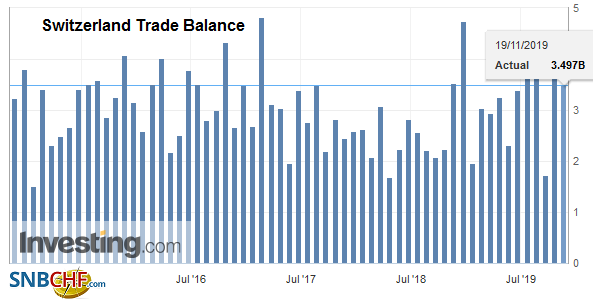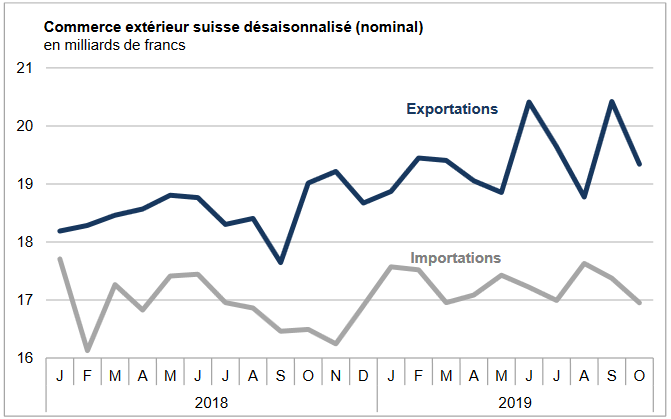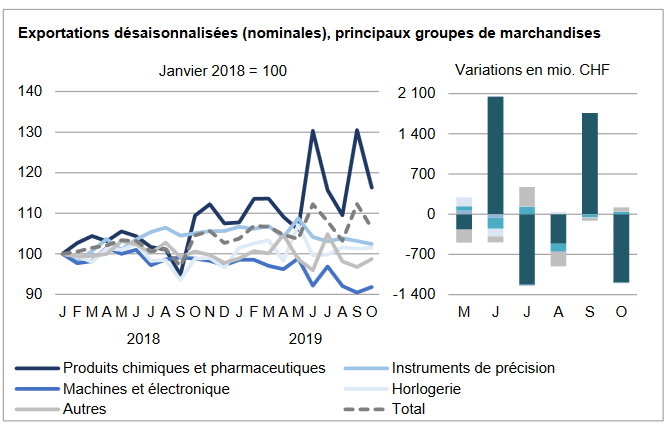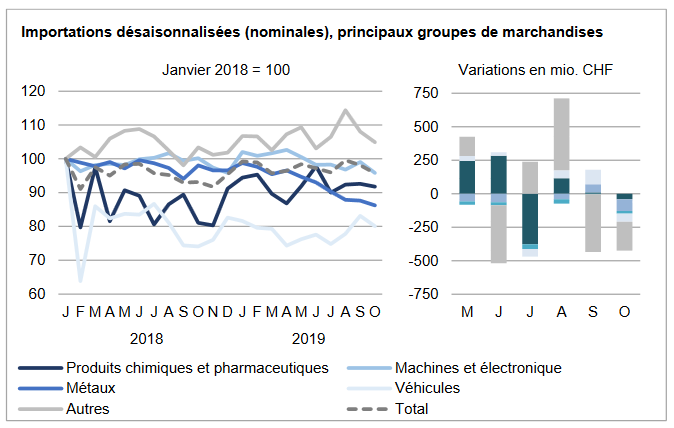We do not like Purchasing Power or Real Effective Exchange Rate (REER) as measurement for currencies. For us, the trade balance decides if a currency is overvalued. Only the trade balance can express productivity gains, while the REER assumes constant productivity in comparison to trade partners. Who has read Michael Pettis, knows that a rising trade surplus may also be caused by a higher savings rate while the trade partners decided to spend more. This is partially true. Recently Europeans started to increase their savings rate, while Americans reduced it. This has led to a rising trade and current surplus for the Europeans. But also to a massive Swiss trade surplus with the United States, that lifted Switzerland on the U.S. currency manipulation watch list. To
Topics:
George Dorgan considers the following as important: 2.) Trade Balance News Service Bunt [FR], 2) Swiss and European Macro, Featured, newsletter, Switzerland Exports, Switzerland Exports by Sector, Switzerland Imports, Switzerland Imports by Sector, Switzerland Trade Balance
This could be interesting, too:
Nachrichten Ticker - www.finanzen.ch writes Die Performance der Kryptowährungen in KW 9: Das hat sich bei Bitcoin, Ether & Co. getan
Nachrichten Ticker - www.finanzen.ch writes Wer verbirgt sich hinter der Ethereum-Technologie?
Martin Hartmann writes Eine Analyse nach den Lehren von Milton Friedman
Marc Chandler writes March 2025 Monthly
We do not like Purchasing Power or Real Effective Exchange Rate (REER) as measurement for currencies. For us, the trade balance decides if a currency is overvalued. Only the trade balance can express productivity gains, while the REER assumes constant productivity in comparison to trade partners.
Who has read Michael Pettis, knows that a rising trade surplus may also be caused by a higher savings rate while the trade partners decided to spend more. This is partially true. Recently Europeans started to increase their savings rate, while Americans reduced it. This has led to a rising trade and current surplus for the Europeans. But also to a massive Swiss trade surplus with the United States, that lifted Switzerland on the U.S. currency manipulation watch list.
To control the trade balance against this “savings effect”, economists may look at imports. When imports are rising at the same pace as GDP or consumption, then there is no such “savings effect”.
After the record trade surpluses, the Swiss economy may have turned around: consumption and imports are finally rising more than in 2015 and early 2016. In March the trade surplus got bigger again, still shy of the records in 2016.
Swiss National Bank wants to keep non-profitable sectors alive
Swiss exports are moving more and more toward higher value sectors: away from watches, jewelry and manufacturing towards chemicals and pharmaceuticals. With currency interventions, the SNB is trying to keep sectors alive, that would not survive without interventions.
At the same time, importers keep the currency gains of imported goods and return little to the consumer. This tendency is accentuated by the SNB, that makes the franc weaker.
Texts and Charts from the Swiss customs data release (translated from French).
Exports and Imports YoY DevelopmentIn October 2019, Swiss foreign trade declined in both traffic directions. Exports fell sharply (-5.3%); however, they had jumped 8.8% the previous month, setting the bar very high. Imports fell 2.4%. Since the beginning of the year, foreign trade has thus revealed stagnation. The trade balance closes with a surplus of 2.4 billion francs. In short: ▼ ▲ Pharma exports have been “yoyo” since the beginning of 2019 ▼ The decline in imports concerns a wide range of products ▲ Exports to China reach record monthly level |
Swiss exports and imports, seasonally adjusted (in bn CHF), October 2019(see more posts on Switzerland Exports, Switzerland Imports, ) |
Overall evolutionAfter seasonally-adjusted exports (+ 8.8%), seasonally-adjusted exports contracted 5.3% in October 2019 (-1.1 billion francs, real -1.3%). Despite strong volatility in the last six months, exports have stagnated since the beginning of the year. Down 2.4%, imports also show a flat trend over the same period (real: -2.4%). In October 2019, the surplus in the trade balance reached 2.4 billion francs. |
Switzerland Trade Balance, October 2019(see more posts on Switzerland Trade Balance, ) Source: investing.com - Click to enlarge |
ExportsAfter their record of the previous month, exports to the US collapse of 992 million francs In October 2019, the sharp drop in output almost exclusively resulted from the drop in exports of chemicals and pharmaceuticals (-10.9% or – CHF 1.2 billion); the previous month, this sector had in contrast posted a rise of 19.2% (+1.8 billion). The monthly ups and downs of previous months is partly due to cyclical production effects specific to this sector. In addition to drugs, the active ingredients have particularly suffered. Jewelery and jewelery (other goods group) contracted by 7.6% (- 81 million). On the other hand, sales in the machinery and electronics sector rose by 1.5%. Watch sales, for their part, slightly increased over one month. Exports fell in the three main markets, especially North America (USA: -22.6% or -992 million francs, pharma). Europe fell by 1.9%, weighed down notably by France and Austria (-204 million in total). Turnover with Asia decreased by only 0.5%. Sales to China swelled by 16.4% while those in Japan plunged 15.7%. Those in the United Arab Emirates have also been reduced by more than one-third (-124 million). Shipments to the Asian continent have stagnated since the beginning of the year. |
Swiss Exports per Sector October 2019 vs. 2018(see more posts on Switzerland Exports, Switzerland Exports by Sector, ) |
ImportsImports: second consecutive setback for jewelery (-160 million francs) In October 2019, the contraction in imports concerned a wide range of products. Jewelery (groupother merchandise) was the hardest hit with a decline of 10.5% over one month (-160 million francs). Note also the downside of the machinery and electronics sector (-3.3%) and the one of vehicles (- 3.7%). In October 2019, imports from major supply markets deteriorated. Those from North America plummeted (USA: -16.7%, -199 million francs). Arrivals from Asia decreased by 2.6%. Here, the decline of the United Arab Emirates (-298 million) contrasted with the jump of Singapore (+ 167 million). On the European continent (-1.8%), the United Kingdom (-131 million) and Austria (-127 million) were hit hard. Ireland has experienced a reverse trend, up 340 million (pharma) over one month. Shipments from Latin America also shone (+139 million). |
Swiss Imports per Sector October 2019 vs. 2018(see more posts on Switzerland Imports, Switzerland Imports by Sector, ) |
Tags: Featured,newsletter,Switzerland Exports,Switzerland Exports by Sector,Switzerland Imports,Switzerland Imports by Sector,Switzerland Trade Balance



